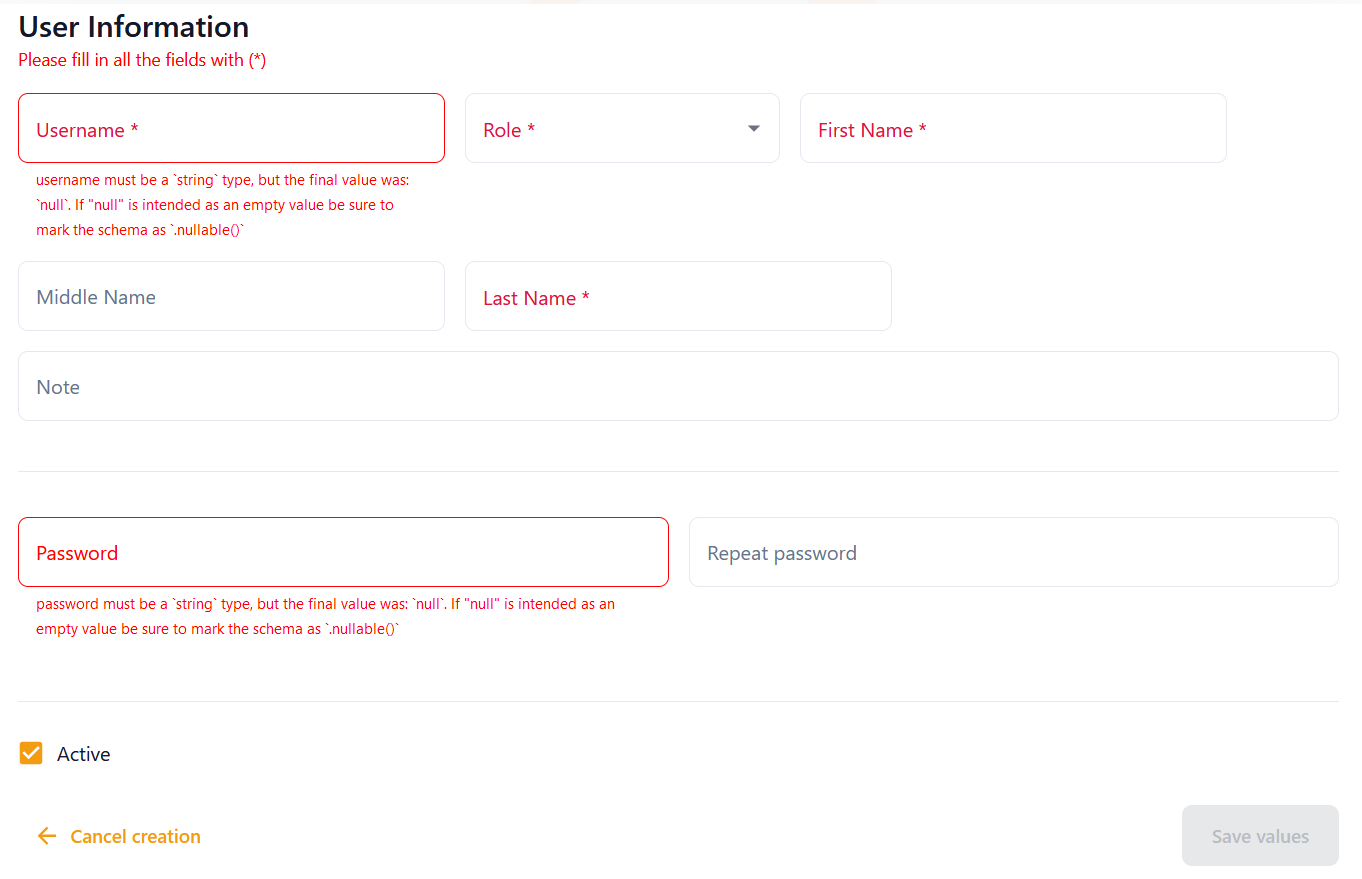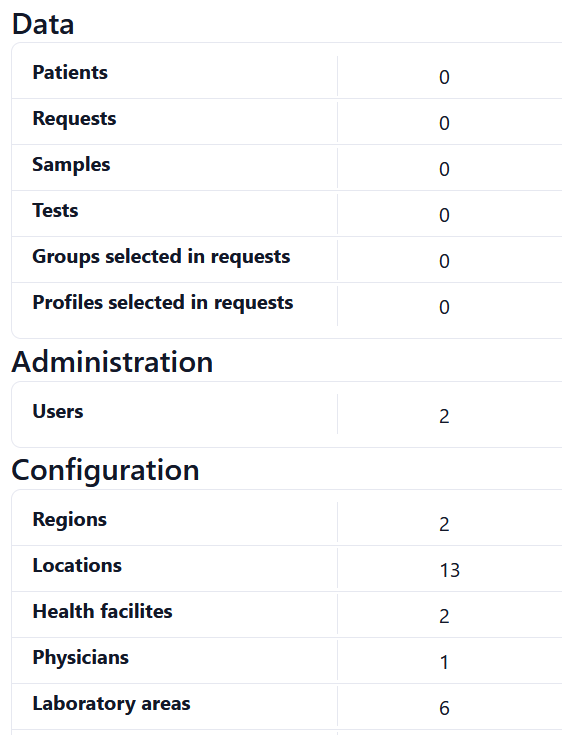System administration/pt: Difference between revisions
Created page with "===Usuários=== right|thumb|750px|Formulário de criação de usuário Ao clicar nos botões "Editar" ou "Novo usuário", um formulário é exibido na tela. As informações necessárias para criar um usuário consistem em "Nome de usuário", "Nome", "Nome do meio", "Senha" e a Função da pessoa no sistema. Esta função determinará as funcionalidades disponíveis para o usuário. Uma nota, sem qualquer efeito no comportamento do apl..." |
Created page with "Este mesmo formulário permite que o administrador do sistema modifique a senha de qualquer outro usuário. Por razões de segurança, esta senha deve conter algum número, alguma letra maiúscula, alguma letra minúscula e pelo menos oito caracteres." |
||
| Line 48: | Line 48: | ||
Uma nota, sem qualquer efeito no comportamento do aplicativo, pode ser adicionada para indicar qualquer informação relevante ao administrador do sistema. | Uma nota, sem qualquer efeito no comportamento do aplicativo, pode ser adicionada para indicar qualquer informação relevante ao administrador do sistema. | ||
Este mesmo formulário permite que o administrador do sistema modifique a senha de qualquer outro usuário. | |||
Por razões de segurança, esta senha deve conter algum número, alguma letra maiúscula, alguma letra minúscula e pelo menos oito caracteres. | |||
<div lang="en" dir="ltr" class="mw-content-ltr"> | <div lang="en" dir="ltr" class="mw-content-ltr"> | ||
Revision as of 00:43, 20 May 2025
Isso agrupa todos os botões que permitem gerenciar e adaptar o comportamento do ARIS às necessidades do laboratório e às preferências do usuário. Eles são agrupados em dois para facilitar seu acesso. O primeiro é mais genérico e permite que tanto o supervisor do laboratório quanto a administração do sistema acessem algumas informações básicas. O segundo está disponível apenas para o administrador do sistema, pois é considerado como exigindo habilidades tecnológicas mais avançadas.

Genérico
Isso agrupa todas as funcionalidades básicas de administração. Eles estão disponíveis tanto para a administração do sistema quanto para o supervisor do laboratório.
Usuários

Ao clicar nos botões "Editar" ou "Novo usuário", um formulário é exibido na tela. As informações necessárias para criar um usuário consistem em "Nome de usuário", "Nome", "Nome do meio", "Senha" e a Função da pessoa no sistema. Esta função determinará as funcionalidades disponíveis para o usuário. Uma nota, sem qualquer efeito no comportamento do aplicativo, pode ser adicionada para indicar qualquer informação relevante ao administrador do sistema.
Este mesmo formulário permite que o administrador do sistema modifique a senha de qualquer outro usuário. Por razões de segurança, esta senha deve conter algum número, alguma letra maiúscula, alguma letra minúscula e pelo menos oito caracteres.
Since they are used for auditing changes in patients and requests, the users cannot be deleted from the system. However, they can be declared not to be active, which would prevent them from logging in, but still keep track in the database of all their past actions.
Access log
The access log shows the user which user has done an action within the system and exactly when. The timestamp is in the format Year-Month-Day Hour:Minute:Second

There are three actions recorded by the access log, successful log in, wrong user and failed log in. This last action refers to the wrong password being used.
Downloaded fields
ARIS allows the laboratory supervisor to download all the information in the database into a single file in their computer. There are two possible download options, depending on the format of the generated file being plain CSV or compressed and password-protected ZIP. These documents will contain information on the requests, and by extension, on the corresponding patients. Thus, due to patient confidentiality, not all the personal data should be in the downloaded file. The checkboxes in this form allow the laboratory supervisor as well as the system administrator to decide which fields will be downloaded in each one of the formats.
Além disso, o sistema fornece dois parâmetros de configuração para personalizar a estrutura do arquivo CSV: "csv_delimiter", que define o caractere usado para separar os campos de dados no arquivo CSV, e "csv_decimal", que especifica o caractere usado para representar valores decimais em campos numéricos. É essencial configurar esses parâmetros de acordo com as configurações usadas pelo sistema e pelo software de planilha (por exemplo, Excel) para garantir a interpretação correta dos dados. O uso de um delimitador ou separador decimal incorreto pode resultar em problemas de formatação ao abrir o arquivo.
Technical
This groups all the more advanced administration functionalities. They are available only for the system administration.
Summary of instances

This tab displays information about the different existing instances in the application. Some examples are: the number of patients, users, requests or genders. This information comes directly from the database and is automatically updated after every modification in the system. It can be useful to investigate potential performance problems in case of extremely large numbers. To facilitate the reading and identification of the different kinds of instances, the information is divided into three sections: Data, Administration and Configuration.
Roles
This tab is displayed and works, in the same way as the State of the request tab in the Configuration functionality. The roles are unchangeable, but their labels (not the corresponding functionality) can be customized.
Each role has different actions allowed within the application, chosen due to the tasks the people are expected to carry out. Thus, there are five roles within the system, which indicate the functionalities that a user can perform, as can be seen in the following table.
Parameters
Parameters determine the behaviour of some functionalities. Thus, they cannot be created or deleted. However, their values can be updated to customize the system. At this point it is important to highlight the on updating them, the data type must be respected. Providing a value of the wrong data type (e.g., a string instead of an integer) can provoke the malfunction of the whole application.
The following table contains the list of existing parameters together with the corresponding data type and a brief description.